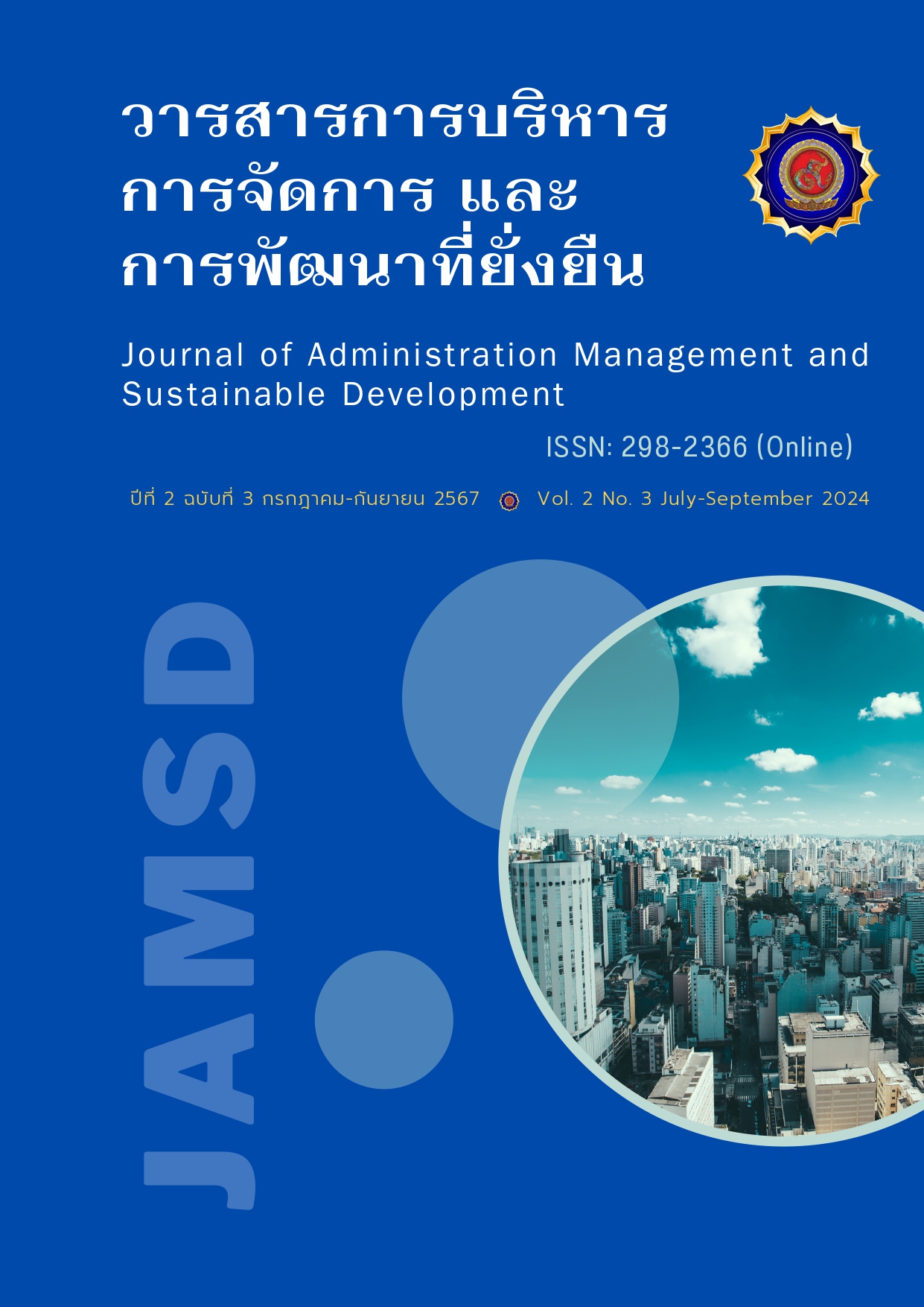บทบาทของนวัตกรรมในการปฏิรูประบบราชการยุคดิจิทัล
คำสำคัญ:
นวัตกรรม;, ระบบราชการ;, เทคโนโลยีบทคัดย่อ
บทความวิชาการนี้มีวัตถุประสงค์เพื่ออธิบายถึงความหมายและความสำคัญของนวัตกรรมในบทบาทของระบบราชการที่นำเข้ามาใช้ในยุคดิจิทัล แนวความคิดและทฤษฎีเกี่ยวกับการนำนวัตกรรมเข้ามาใช้ในยุคดิจิทัล ประเภทของนวัตกรรม ประโยชน์ของนวัตกรรม รวมถึงข้อดีข้อเสียและแนวทางการนำนวัตกรรมเข้ามาบริหารจัดการหน่วยงานราชการ เพื่อให้เข้าใจถึงบทบาทของนวัตกรรมที่ระบบราชการได้นำเข้ามาปรับใช้ในการทำงานให้มีความรวดเร็วและมีประสิทธิภาพ
ในการบริการสาธารณะมากยิ่งขึ้น ระบบราชการได้นำเทคโนโลยีมาปรับใช้ในการบริการสาธารณะเพื่อให้ประชาชนได้รับการบริการที่สะดวกสบายในการดำเนินชีวิตในยุคดิจิทัล ดังนั้นการบริหารหน่วยงานหรือองค์กรภาครัฐจึงจำเป็นที่ต้องนำนวัตกรรมใหม่ๆเข้ามามีบทบาทสำคัญในการเปลี่ยนแปลงรูปแบบการทำงานในทุกภาคส่วนหรือระบบราชการด้วย การปฏิรูปการทำงานในระบบราชการให้สอดคล้องกับยุคดิจิทัลยังเป็นสิ่งที่หลีกเลี่ยงไม่ได้เพราะนวัตกรรมยังคงเป็นโอกาสที่สำคัญในการยกระดับให้มีคุณภาพการทำงานของภาครัฐได้ดียิ่งขึ้น เพื่อให้บริการประชาชนได้อย่างรวดเร็วทันสมัย ตอบสนองความต้องการของประชาชนแต่อย่างไรก็ตามการนำนวัตกรรมยุคใหม่เข้ามาใช้ก็มีความท้าทายและมีอุปสรรคมากมายที่ระบบราชการ
ต้องพิจารณาตัดสินใจที่ปฏิรูปการทำงานในระบบราชการใหม่ๆโดยต้องคำนึงถึงประสิทธิการทำงาน ลดเวลาในการดำเนินงาน ตรวจสอบความแม่นยำของข้อมูล เพื่อให้การบริการรวดเร็วและประชาชนเข้าถึงง่าย นวัตกรรมเป็นกระบวนการของ
การพัฒนาความคิดโดยใช้ทรัพยากรที่มีอยู่หรือมาจากการที่มนุษย์สร้างขึ้นและระบบราชการได้นำบทบาทของนวัตกรรมเข้ามาปฏิรูปการดำเนินงานขององค์กร แต่ต้องมีการวางแผนและเตรียมการอย่างรอบคอบ เพื่อให้เกิดประโยชน์สูงสุด ดังนั้นระบบราชการได้ปรับเปลี่ยนการทำงานและเน้นการนำแนวคิดขององค์การภาคเอกชนมาใช้ในหน่วยงานภาครัฐให้ความสำคัญกับคนและเทคโนโลยีมากขึ้น เพื่อให้ประชาชนได้นำองค์ความรู้ทางด้านนวัตกรรมไปประยุกต์ใช้ในชีวิตประจำวัน ในการทำงานหรือการพัฒนาหน่วยงานต่าง ๆ การเปลี่ยนแปลงของเทคโนโลยีในยุคปัจจุบันควรมีการพัฒนาบุคลากรให้มีความรู้ความสามารถในการใช้เทคโนโลยี ระบบราชการจึงปฏิรูปการทำงานโดยนำนวัตกรรมมามีบทบาทสำคัญที่ช่วยให้ประเทศ
มีความเจริญก้าวหน้าในการดำเนินงานในยุคดิจิทัลกับโลก 4.0 ที่ขับเคลื่อนด้วยเทคโนโลยี
เอกสารอ้างอิง
สำนักงานพัฒนารัฐบาลดิจิทัล. (2563). แผนพัฒนารัฐบาลดิจิทัลของประเทศไทย. กรุงเทพฯ: สำนักงานพัฒนารัฐบาลดิจิทัล.Bekkers, V. J. J. M., & Homburg, V. M. (2007). The Role of Innovation in Public Administration. Palgrave Macmillan.
Borins, S. (2014). Innovations in Governance and Public Administration: A Global Perspective. Routledge.
Brown, J. (2023). Innovation in public administration: Challenges and opportunities. Public Management Review, 25(1), 45-62.
Birkinshaw, J., Hamel, G., & Mol, M. J. (2008). Management innovation. Academy of Management Review, 33(4), 825-845.
Cameron, E., & Green, M. (2015). Making sense of change management: A complete guide to the models, tools and techniques of organizational change. Kogan Page Publishers.
Chotchai, S. (2022). Innovations in Thai public administration: Enhancing efficiency and transparency. Journal of Public Administration, 18(3), 112-127.
Christensen, C. M. (1997). The innovator’s dilemma: When new technologies cause great firms to fail. Harvard Business Review Press.
Dawes, S. S. (2016). The Role of Technology in Government and Public Administration: Key Challenges
and Opportunities. Public Administration Review, 76(2), 210-219.
Deming, W. E. (1986). Out of the crisis. MIT Center for Advanced Educational Services.
Freeman, C., & Soete, L. (1997). The Economics of Industrial Innovation. Routledge.
Gurstein, M. (2019). "The Role of Digital Technology in Social Change and Public Administration: Opportunities and Challenges". Information Technology for Development, 25(3), 431-445.
Heeks, R. (2018). Digital government: Technology and public sector reform. Routledge.
Hiatt, J. M. (2006). ADKAR: A model for change in business, government, and our community. Prosci Research.
Kettunen, P., & Kallio, J. (2020). Innovation and digitalization in public administration.
Kim, S. (2019). Digital government and public sector innovation: New approaches to public administration.
Kotter, J. P. (1996). Leading change. Harvard Business Review Press.
Kshetri, N. (2020). The Emerging Role of Digital Technologies in Public Administration. In Digital Transformation and Global Society (pp. 11-23). Springer.
Lewin, K. (1951). Field theory in social science: Selected theoretical papers. Harper & Brothers.
Long, Y. (2021). "Challenges and Risks of Implementing Technological Innovations in Public Sector
Organizations". Journal of Public Administration Research and Theory, 31(1), 15-29.
Margetts, H., & Dunleavy, P. (2013). The Future of Public Services: How to Innovate in a Digital World. Oxford University Press.
Mergel, I. (2016). Social media and the public sector: Governance, participation, and transparency. Routledge.
Mergel, I., Edelmann, N., & Haug, N. (2019). The Role of Digital Innovation in the Public Sector: A Systematic Review. Public Administration Review, 79(6), 923-934.
Mulgan, G. (2012). The Locust and the Bee: Predators and Creators in Capitalism's Future. Princeton University Press.Mulgan, G. (2012). The Locust and the Bee: Predators and Creators in Capitalism's
Osborne, S. P., & Brown, K. (2005). Managing change and innovation in public service organizations. Routledge.
Osborne, S. P., & Brown, K. (2013). Innovation in Public Services: How to Create and Sustain Innovation in Public Sector Organizations. Routledge.
Peters, B. G., & Wooldridge, J. (2022). The future of public service: Digitalization and beyond. Government Studies Journal, 29(2), 123-136.
Phan, T. (2021). Digital Innovation and Public Administration: Impacts and Strategies. Public Administration Review, 81(4), 564-579.
Powell, W. W., Koput, K. W., & Smith-Doerr, L. (1996). Interorganizational collaboration and the local search for innovation. Administrative Science Quarterly, 41(1), 116-145.
Routledge. Moon, M. J., & Norris, D. F. (2019). Digital era governance: IT corporations, the state, and e-government. Routledge.
Schein, E. H. (2010). Organizational culture and leadership. Jossey-Bass.
Smith, A. (2021). Reducing costs through digital transformation in government sectors. Public Administration Quarterly, 38(3), 201-215.
Smith, S. R. (2009). Public service innovation: A critical overview. Public Administration Review, 69(2), 182-192.
Sutthipong, N. (2023). Innovation in Public Administration: Enhancing Efficiency and Transparency in the Digital Era. Public Sector Innovation Journal, 12(2), 45-63.
Thompson, L. (2020). Enhancing efficiency in government through innovation and automation. Journal of Public Sector Innovation, 15(4), 98-115
UNDP. (2020). Digital transformation for development. United Nations Development Programme.
Williams, T. (2002). Modelling complex projects. John Wiley & Sons.
Wong, K. (2022). Harnessing Digital Innovation in Public Administration: Strategies and Challenges. Journal of Public Sector Innovation, 15(3), 78-92.



